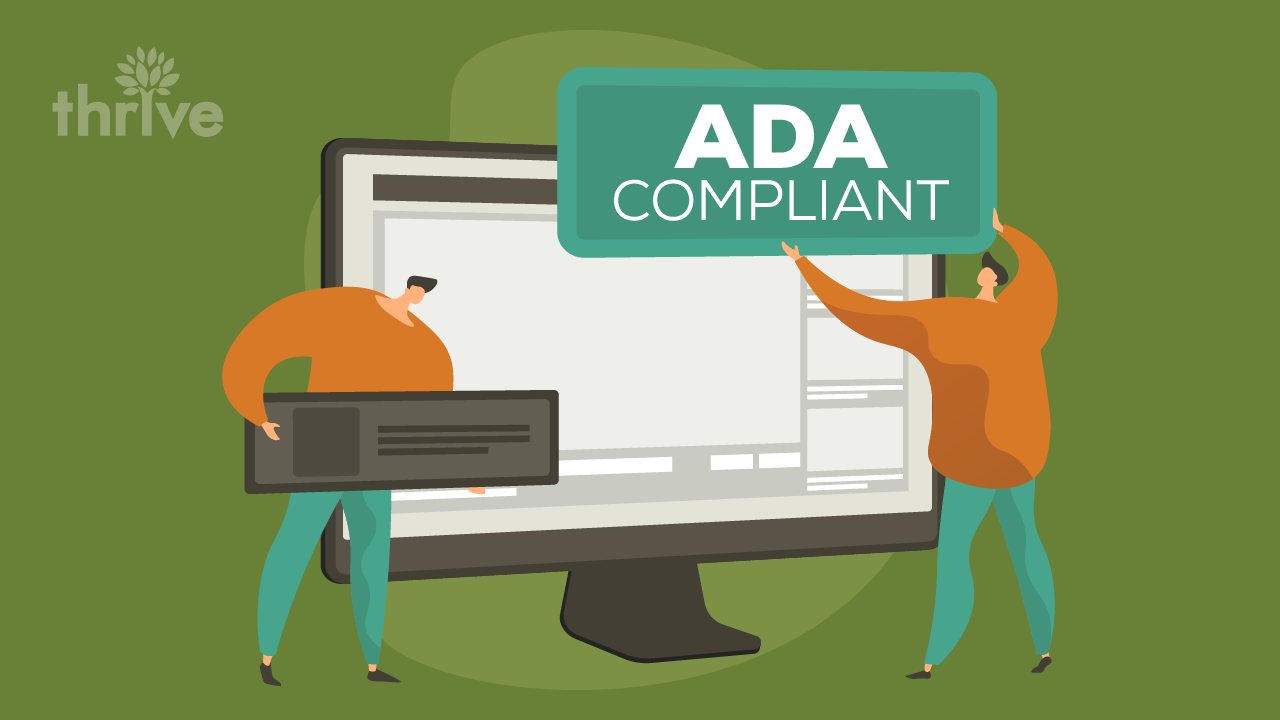Is your website compliant with the Americans with Disabilities Act (ADA)? If you said “no” or “not sure,” it’s time to consider the risks and take action.
By building a website, businesses can reach the widest audience possible. It’s therefore considered worthwhile to invest time, money and effort into creating one. But as the primary channel for accommodating clients or customers, is your website living up to its potential? In an inclusive digital economy, that means being accessible to everyone.
Some companies have realized that that isn’t the case for them via a costly wake-up call: an ADA compliance lawsuit. Yes, you can get sued for failing to provide a user-friendly experience to someone with a disability.
ADA compliance is about making sure your site is accessible to all, regardless of their physical limitations. Website accessibility requires removing barriers by, for instance, making your content compatible with screen readers – a form of assistive technology that helps those who are blind or visually impaired to navigate web pages.
If your web design is found by the court to have violated accessibility standards, you can face a losing verdict in an ADA website compliance case. Recovering from an ADA lawsuit is hard, especially if you’re a small or medium enterprise. It can result in your finances, reputation and revenue taking a hit. And you can have it worse on all fronts compared to your larger, deep-pocketed peers.
When it comes to ADA lawsuits, prevention is still better than cure.
In this article, we discuss how you can make your site compliant with ADA and technical standards like the Web Content Accessibility Guidelines (WCAG). To deliver a better understanding of the matter, we delve into:
• The Web Content Accessibility Guidelines (WCAG)
• Who is affected by the Americans with Disabilities Act (ADA) lawsuits
• The consequences of non-compliance
• How to create an ADA compliant website
• Being proactive about ADA website compliance
What Is the Web Content Accessibility Guidelines (WCAG)?
ADA compliance is an umbrella term used to describe efforts to make a website accessible to people with disabilities. The goal is to ensure they encounter zero issues while browsing your web pages. But you may have heard about other standards that overlap with ADA, like the Web Content Accessibility Guidelines (WCAG) and Section 508.
What do these terms mean and how are they different from each other? Let’s find out.
Section 508
This is a law that requires federal agencies to make accommodations for individuals with disabilities, whether they are employees or not, in developing, procuring, maintaining and using information and communication technology (ICT) such as government websites.
Who should implement the Section 508 standards?
Federal agencies, federal-funded projects and specific state and local governments.
ADA
Enacted in 1990 and updated in 2008, this civil rights law seeks to protect against discrimination based on disability. It demands equal opportunities for everyone, making public activities accessible to people with disabilities, from sitting and walking to watching movies and buying goods and services.
Who should implement the ADA standards?
Public and private sectors, including small to midsize businesses and nonprofit organizations. Even if you have fewer than 15 employees, you must be ADA compliant.
WCAG
Unlike the first two, this set of guidelines isn’t law and cannot enforce compliance. Developed by the World Wide Web Consortium (W3C), it outlines the technical requirements for creating accessible content.
The latest versions of WCAG are the Web Content Accessibility Guidelines WCAG 2.0 and WCAG 2.1. Some websites still adhere to WCAG 2.0, but striving to meet WCAG 2.1 is ideal.
Who should implement the WCAG standards?
Every website under ADA and Section 508 in the United States is expected to comply since both laws adopted WCAG’s accessibility standards. That puts WCAG compliance on top of any ADA compliant website checklist.
Here’s a quick WCAG compliance checker for meeting Web Content Accessibility Guidelines WCAG 2.0 and 2.1:
• For a website to be accessible, it should be perceivable, operable, understandable and robust (the four principles).
• Guidelines are grouped under each principle.
• Apply success criteria where compliance testing is needed. There are three levels of conformance: A (lowest), AA (what most organizations aim for) and AAA (highest).
• Two kinds of techniques are documented: sufficient (provided for meeting the success criteria) and advisory.
Did you find most of it confusing? Don’t fret; there’s a reason for that.
WCAG compliance focuses on HTML accessibility. HTML stands for Hypertext Markup Language, a computer language used to define the elements (like font sizes and colors) on a web page. It can be code-intensive and confusing for those who have little to no technical background. To ensure conformance and avoid getting hit by an ADA website lawsuit, you can hire a team of web designers and developers to address the items on your WCAG compliance checker and ADA compliant website checklist.
Who Is Affected by the Americans with Disabilities Act Lawsuits?
Failure to comply with ADA website accessibility standards has landed some famous companies in hot water.
Domino’s Pizza suffered a big blow when the Supreme Court dismissed its appeal for a lower court ruling, which had allowed the ADA lawsuit filed by Guillermo Robles to proceed. Robles, a blind man, had sought compensation over a violation of his right to fully access the pizza chain’s website and app. Both channels were said to be incompatible with the plaintiff’s screen reader, which had prevented him from successfully ordering a customized pizza at least twice.
“The alleged inaccessibility of Domino’s website and app impedes access to the goods and services of its physical pizza franchises – which are places of public accommodation,” said a panel of the 9th U.S. Circuit Court of Appeals.
More ADA lawsuits alleged that several websites, from Beyonce’s to Winn-Dixie’s, prohibited visually impaired users from accessing goods and services. Even the country’s elite universities like Harvard and the Massachusetts Institute of Technology (MIT) weren’t spared. They also faced complaints citing the lack of closed captioning that made their online content inaccessible to the deaf and hard of hearing.
Although big corporations were involved in each ADA website compliance lawsuit mentioned above, they’re not the only ones affected. Small and medium businesses were included in the 11,053 accessibility cases filed in 2019, a 9 percent increase over 2018.
All industries are also affected. But others are just more prone to be sued, such as the following:
• Automotive
• eCommerce
• Education
• Entertainment
• Fashion
• Finance
• Health care
• Media
• Real estate
• Restaurant/Food and beverage
What Are the Consequences of ADA Non-Compliance?
An ADA website lawsuit is not the only risk you’ll face if you ignore accessibility standards. Think about the following consequences of non-compliance and their impact on your business:
• Miss out on SEO opportunities – Understanding the search engine optimization (SEO) and accessibility overlap allows you to optimize well for both. When you enhance accessibility by adding or editing image alt tags, audio/video captions, sitemaps and text size and color contrast, you’re also covering some technical SEO elements.
• Erode your reputation – While not all users with disabilities may file an ADA lawsuit, they can still hurt your online reputation if they tell others about your site’s inaccessibility. Search engines can also count it toward your bounce rate if these visitors are leaving your site without taking any action.
• Lose to your competitors – When a visually impaired or hard of hearing person leaves your website, where do they go? To a competitor’s site that’s accessible, of course! You shouldn’t take this matter lightly or underestimate the spending power of working-age adults with disabilities. Last time we checked, they have a disposable income of $490 billion.
So you see, inaction can cost you more than a preventive compliance service can. Don’t wait for an ADA website compliance lawsuit before doing something. Aside from paying for attorney fees, court fees and a possible settlement fee, you’ll spend on making your website compliant if you lose the accessibility case. The court may also ask you to:
• Implement web accessibility solutions to conform with WCAG 2.1 criteria
• Satisfy the requirements on your ADA compliant website checklist
• Publish an accessibility policy on your website
• If you have an in-house development team, let them undergo ADA assistance and web accessibility training
Now, consider the expense that comes with doing good housekeeping and prioritizing website accessibility. Instead of worrying about ADA lawsuits, you can focus on providing your customers or clients with the best products or services. Enlisting the help of a third party that offers ADA compliance services also prevents do-overs or errors that can trip you up and send you off to a drawn-out legal battle.
Can we also agree on the part that it’s hard to put a price on fulfilling your moral obligation to the digital audience you’re trying to reach?
How To Create an ADA Compliant Website
There’s no time to waste when an individual with a disability could be checking out your website now. Achieving an ADA compliant website is the right thing to do and it requires your attention, commitment and dedication.
Here are steps you can take to meet accessibility standards and prevent a costly ADA website compliance lawsuit:
• Perform a site audit to check if the website is compliant.
Identify priority areas to review, such as pages that can serve as templates. Remember the applicable regulatory and technical requirements: ADA, Section 508 and WCAG 2.1. We highly suggest you refer to the WCAG 2.1 resource if you previously aligned with the Web Content Accessibility Guidelines WCAG 2.0.
• Create an ADA/WCAG compliance checker report.
List the accessibility issues you found together with their severity and impact. Include recommendations on how to fix the issues.
Here are some examples of recommendations:
1. Add alt text to all images, videos and audio files.
2. Create captions and transcripts for multimedia content.
3. Place navigation menus, links and text sections in predictable locations.
4. Remove auto-playing media.
5. Use specific, unique and descriptive names for your links (Read About Us vs Read More).
• Leverage free tools.
Take advantage of free tools to make the first two steps easier. You can start with the web content evaluation tools list compiled by W3C.
• Build your compliant website in-house.
The WCAG checklist (linked earlier) is a good place to start if you are planning to do your compliance testing through your web development team. Again, your team should have undergone training to ensure effective implementation.
• Employ a professional agency.
In the absence of a properly trained staff, the sheer number of guidelines on the WCAG checklist can overwhelm a website owner. Entrust the process to a professional ADA website compliance agency that knows how to navigate the checklist and other existing standards. Even better, you get positive results in a cost-effective and timely manner, which are essential to rolling out an accessible site to people with disabilities.
Outsourcing can yield an optimal return on investment (ROI), and, as we’ve explained, the rewards that come with “prevention” are a stark contrast to the losses attached to the “cure”.
Being Proactive About ADA Website Compliance
An ADA compliant website is user-friendly to the point that it does not discriminate against any user, including those with disabilities. It makes business sense to make your site accessible now to avoid the legal, financial and even moral repercussions later.
It is this proactive take that should rule businesses wanting to reach the widest audience possible. We hope that it is this position that you find yourself in after learning about the accessibility standards and their ongoing role as a checkpoint whenever you have to make changes on your website.
You also read about how ADA website lawsuit numbers have risen in recent years. The data tells us the consequences of non-compliance are real and non-compliance is no longer an option.
To navigate this constantly shifting landscape, you need to build a relationship with someone who knows the nitty-gritty of ADA compliance. At Thrive, we have the expertise and tools to assist any business or website owner. Our integrated custom web design and ADA compliance services come with software that fixes errors and an advanced artificial intelligence (AI) tool that adjusts to screen readers used by visually impaired people.
To get started with an accessibility audit and achieve ADA compliance in no time, drop us a message or give us a call at 866-908-4748 today.







